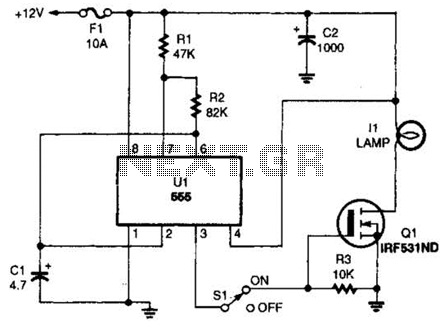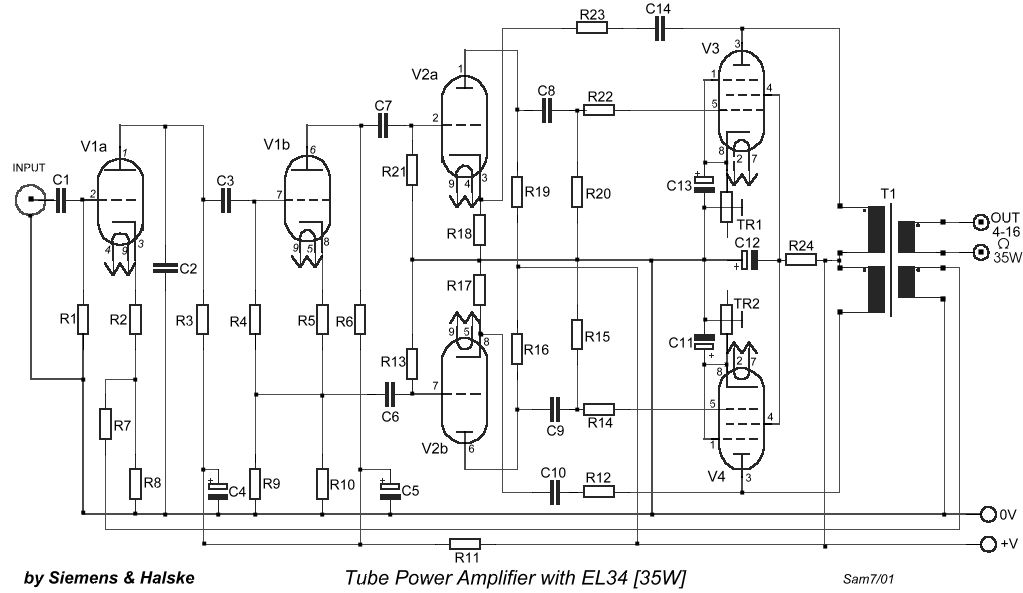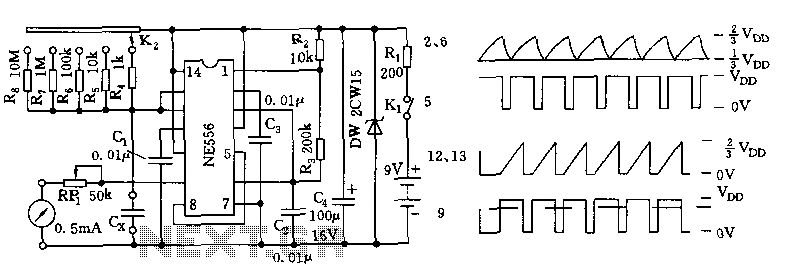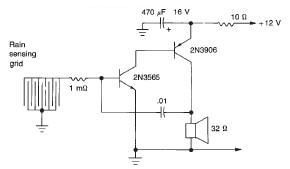
Musical Car Reverse Horn Circuit PCB
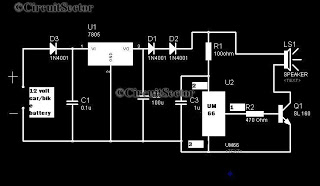
A simple musical horn circuit designed for use in cars or motorcycles can be connected to the 12V battery of any vehicle. This circuit is commonly utilized as a reverse musical horn. It employs the low-cost musical integrated circuit (IC) UM66, which can only handle supply voltages below 4V. To address this limitation, a 7805 voltage regulator IC is used to adjust the voltage to 5V, which is then further reduced to 3.8V by connecting two diodes, D1 and D2, before supplying it to the UM66 musical horn producer. When a 12V supply is connected to the musical horn circuit, it produces music continuously. A switch is required to connect the battery to the circuit, allowing music to play when the reverse gear is engaged. An alternative setup can be implemented to automatically play sound while reversing, although this requires advanced skills.
The circuit consists of several key components: a 12V battery, a 7805 voltage regulator, two diodes (D1 and D2), and the UM66 musical IC. The 7805 voltage regulator is essential for stepping down the voltage from 12V to a manageable level for the UM66. The output of the 7805 is typically 5V, but by using two silicon diodes in series, the voltage is reduced to approximately 3.8V, which is within the acceptable range for the UM66 to operate effectively.
The circuit's functionality is straightforward. When the vehicle's ignition is on, the switch connects the 12V battery to the circuit. The voltage regulator ensures that the UM66 receives the correct voltage, allowing it to generate musical tones. The diodes protect the UM66 from overvoltage conditions, which could damage the IC. The switch acts as a control mechanism; it must be pressed when the vehicle is in reverse to activate the musical horn, providing an audible alert to pedestrians and other vehicles.
For those with advanced skills in electronics, it is possible to modify the circuit to allow for automatic sound playback when the vehicle is in reverse. This would involve additional components such as a relay or a microcontroller to detect the reverse gear engagement and trigger the musical horn without the need for manual switching. Such modifications would enhance the functionality of the circuit, making it a more sophisticated solution for vehicle safety and awareness.Want to make some stuff that fits your car or motor cycle Then here is a simple musical horn circuit that can be connected to the 12V battery of any car or motorcycle. This circuit commonly used as reverse musical horn. Here we use a commercially very low cost musical IC UM66. But this Ic can only handle supply voltage below 4V. So we used a 7805 regulator ic for adjusting the voltage to 5V and its further reduced to 3. 8 volt by connecting two diodes D1 and D2 then it will supplied to musical horn producer UM66. Whenever we supply a 12v to the musical horn circuit, it will always produce music. So we need to connect a switch between battery and circuit and when you want to move on reverse gear, the switch must be pressed to produce music. ( You can setup the circuit to automatically plays sound while reversing the car but it requires more skill to implement)
🔗 External reference
The circuit consists of several key components: a 12V battery, a 7805 voltage regulator, two diodes (D1 and D2), and the UM66 musical IC. The 7805 voltage regulator is essential for stepping down the voltage from 12V to a manageable level for the UM66. The output of the 7805 is typically 5V, but by using two silicon diodes in series, the voltage is reduced to approximately 3.8V, which is within the acceptable range for the UM66 to operate effectively.
The circuit's functionality is straightforward. When the vehicle's ignition is on, the switch connects the 12V battery to the circuit. The voltage regulator ensures that the UM66 receives the correct voltage, allowing it to generate musical tones. The diodes protect the UM66 from overvoltage conditions, which could damage the IC. The switch acts as a control mechanism; it must be pressed when the vehicle is in reverse to activate the musical horn, providing an audible alert to pedestrians and other vehicles.
For those with advanced skills in electronics, it is possible to modify the circuit to allow for automatic sound playback when the vehicle is in reverse. This would involve additional components such as a relay or a microcontroller to detect the reverse gear engagement and trigger the musical horn without the need for manual switching. Such modifications would enhance the functionality of the circuit, making it a more sophisticated solution for vehicle safety and awareness.Want to make some stuff that fits your car or motor cycle Then here is a simple musical horn circuit that can be connected to the 12V battery of any car or motorcycle. This circuit commonly used as reverse musical horn. Here we use a commercially very low cost musical IC UM66. But this Ic can only handle supply voltage below 4V. So we used a 7805 regulator ic for adjusting the voltage to 5V and its further reduced to 3. 8 volt by connecting two diodes D1 and D2 then it will supplied to musical horn producer UM66. Whenever we supply a 12v to the musical horn circuit, it will always produce music. So we need to connect a switch between battery and circuit and when you want to move on reverse gear, the switch must be pressed to produce music. ( You can setup the circuit to automatically plays sound while reversing the car but it requires more skill to implement)
🔗 External reference


